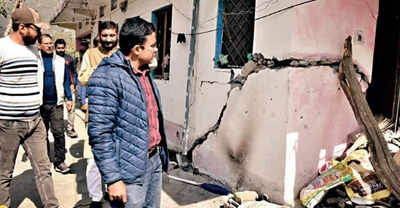Top Searches
- News
- City News
- dehradun News
- Turkey-magnitude earthquake could hit Uttarakhand: Expert
Turkey-magnitude earthquake could hit Uttarakhand: Expert

Chamoli DM Himanshu Khurana (in foreground) toured Karnprayag on Sunday to inspect houses where cracks have appeared
HYDERABAD: An earthquake similar in magnitude to the one that hit Turkey is “imminent” in the fault lines of the Uttarakhand region and can happen “any time”, chief scientist of seismology at the National Geophysical Research Institute (NGRI), Dr N Purnachandra Rao, has warned.
Rao told TOI that a lot of stress is building up beneath the surface in the Uttarakhand region, and a “great earthquake” is inevitable to release the stress. He, however, added that the date and time of the quake cannot be predicted, and the devastation would depend on multiple factors which vary from one geographic area to another.
“We have set up around 80 seismic stations in the Himalayan region focused on Uttarakhand. We are monitoring the situation real-time. Our data shows stress accumulating big time,” he added. “We have GPS networks in the area. GPS points are moving, indicating changes happening beneath the surface.”

Rao said variometric GPS data processing is one of the reliable methods to determine what’s happening with the earth. “We cannot predict the exact time and date, but Uttarakhand will witness a massive earthquake any time,” Rao insisted. Variometers measure variations in the Earth’s magnetic field.
The comments by the top scientist come in the backdrop of ground subsidence in Joshimath, considered the gateway to pilgrim sites like Badrinath and Kedarnath. Also, the Char Dham Yatra, which brings lakhs of pilgrims to the Uttarakhand mountains, is set to start in about two months.
Earthquakes of magnitude 8 and above are called “great earthquakes”. “Turkiye witnessed a 7.8 magnitude earthquake,” he said. “Technically, it cannot be called a great earthquake. But the devastation was high in Turkiye due to multiple factors, including poor quality construction."

In the Himalayan region, which stretches from Jammu and Kashmir to Arunachal Pradesh, an earthquake of 8-plus magnitude is likely to occur, he said.
“Damage depends on multiple factors like population density, buildings, mountains or plains, quality of construction, and soon,” he added. “We expect that magnitude-wise, it can be similar to or more than Turkiye. But devastation, we can't say or comment on as it depends on various other factors.”
Earthquake potential is high in the entire Himalayan region, which had earlier witnessed four great earthquakes, including the Kumaon earthquake of 1720 and the Garhwal earthquake of 1803. The Himalayan range falls in Zone V and zone IV of the earthquake zoning map of India.
However, within this region, Uttarakhand falls within what’s called a “seismic gap” because the state has not experienced a great earthquake of magnitude 8 and above for over 100 years, although two recent quakes of lesser intensity struck Uttarkashi and Chamoli in 1991 and 1999, respectively. The area is constantly accumulating strain and the tension can only be released through an earthquake. “There is something called a return period. Earthquakes recur in areas with fault lines,” said Rao.
Rao told TOI that a lot of stress is building up beneath the surface in the Uttarakhand region, and a “great earthquake” is inevitable to release the stress. He, however, added that the date and time of the quake cannot be predicted, and the devastation would depend on multiple factors which vary from one geographic area to another.
“We have set up around 80 seismic stations in the Himalayan region focused on Uttarakhand. We are monitoring the situation real-time. Our data shows stress accumulating big time,” he added. “We have GPS networks in the area. GPS points are moving, indicating changes happening beneath the surface.”

6.3-magnitude quake hits southern Turkey: Official
Rao said variometric GPS data processing is one of the reliable methods to determine what’s happening with the earth. “We cannot predict the exact time and date, but Uttarakhand will witness a massive earthquake any time,” Rao insisted. Variometers measure variations in the Earth’s magnetic field.
The comments by the top scientist come in the backdrop of ground subsidence in Joshimath, considered the gateway to pilgrim sites like Badrinath and Kedarnath. Also, the Char Dham Yatra, which brings lakhs of pilgrims to the Uttarakhand mountains, is set to start in about two months.
Earthquakes of magnitude 8 and above are called “great earthquakes”. “Turkiye witnessed a 7.8 magnitude earthquake,” he said. “Technically, it cannot be called a great earthquake. But the devastation was high in Turkiye due to multiple factors, including poor quality construction."

“God Bless India…,” Turkish locals express heartfelt gratitude to Indian Army for rescue assistance
In the Himalayan region, which stretches from Jammu and Kashmir to Arunachal Pradesh, an earthquake of 8-plus magnitude is likely to occur, he said.
“Damage depends on multiple factors like population density, buildings, mountains or plains, quality of construction, and soon,” he added. “We expect that magnitude-wise, it can be similar to or more than Turkiye. But devastation, we can't say or comment on as it depends on various other factors.”
Earthquake potential is high in the entire Himalayan region, which had earlier witnessed four great earthquakes, including the Kumaon earthquake of 1720 and the Garhwal earthquake of 1803. The Himalayan range falls in Zone V and zone IV of the earthquake zoning map of India.
However, within this region, Uttarakhand falls within what’s called a “seismic gap” because the state has not experienced a great earthquake of magnitude 8 and above for over 100 years, although two recent quakes of lesser intensity struck Uttarkashi and Chamoli in 1991 and 1999, respectively. The area is constantly accumulating strain and the tension can only be released through an earthquake. “There is something called a return period. Earthquakes recur in areas with fault lines,” said Rao.

About the Author
U Sudhakar ReddySudhakar Reddy Udumula is the Editor (Investigation) at the Times of India, Hyderabad. Following the trail of migration and drought across the rustic landscape of Andhra Pradesh and Telangana, Sudhakar reported extensively on government apathy, divisive politics, systemic gender discrimination, agrarian crisis and the will to survive great odds. His curiosity for peeking behind the curtain triumphed over the criminal agenda of many scamsters in the highest political and corporate circles, making way for breaking stories such as Panama Papers Scam, Telgi Stamp Paper Scam, and many others. His versatility in reporting extended to red corridors of left-wing extremism where the lives of security forces and the locals in Maoist-affected areas were key points of investigation. His knack for detail provided crucial evidence of involvement from overseas in terrorist bombings in Hyderabad.
Start a Conversation
FOLLOW US ON SOCIAL MEDIA
FacebookTwitterInstagramKOO APPYOUTUBE









